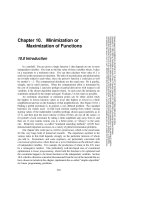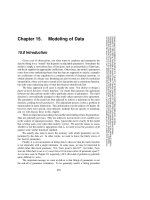Charting Made Easy Part 1 ppt
Bạn đang xem bản rút gọn của tài liệu. Xem và tải ngay bản đầy đủ của tài liệu tại đây (308.65 KB, 21 trang )
Charting
Made
Easy
BB YY
JJ
OO HH NN
JJ MM
UU RR PP HH YYCopyright © 2000 Marketplace Books for portions of the text.
Copyright © 1999 Bridge Commodity Research Bureau for
portions of the text.
Published by Marketplace Books.
Reprinted by arrangement with Bridge/CRB.
MetaStock and MetaStock Professional are trademarks and service
marks of Equis International, Inc., registered in the United States
and other countries. Screen captures for all charts from MetaStock
or MetaStock Professional are © 2001 Equis International, Inc.
All rights reserved.
Marketplace Books would like to express its appreciation to Equis
International and MetaStock for use of their charts.
Reproduction or translation of any part of this work beyond
that permitted by section 107 or 108 of the 1976 United States
Copyright Act without the permission of the copyright owner is
unlawful. Requests for permission or further information should be
addressed to the Permissions Department at Traders’ Library.
This publication is designed to provide accurate and authoritative
information in regard to the subject matter covered. It is sold with
the understanding that neither the author nor the publisher is
engaged in rendering legal, accounting, or other professional service.
If legal advice or other expert assistance is required, the services of a
competent professional person should be sought.
From a Declaration of Principles jointly adopted by a Committee
of the American Bar Association and a Committee of Publishers.
ISBN 1-883272-59-9
Printed in the United States of America.
This book, along with other books, are available at discounts
that make it realistic to provide them as gifts to your
customers, clients, and staff. For more information on these
long lasting, cost effective premiums, please call John Boyer
at 800.272.2855 or e-mail him at
Contents
Introduction . . . . . . . . . . . . . . . . . . . . . . . . . . . . . . . . . . . . . . . ix
Chapter 1
WHY IS CHART ANALYSIS SO IMPORTANT? . . . . . . . . . . . . . 1
Market Timing . . . . . . . . . . . . . . . . . . . . . . . . . . . . . . . . . . . . 2
Chapter 2
WHAT IS CHART ANALYSIS? . . . . . . . . . . . . . . . . . . . . . . . . . . 3
Charts Reveal Price Trends . . . . . . . . . . . . . . . . . . . . . . . . . . 4
Types of Charts Available. . . . . . . . . . . . . . . . . . . . . . . . . . . . 5
Any Time Dimension . . . . . . . . . . . . . . . . . . . . . . . . . . . . . . . 5
Chapter 3
HOW TO PLOT THE DAILY BAR CHART . . . . . . . . . . . . . . . . . 7
Charts Are Used Primarily to Monitor Trends . . . . . . . . . . . . 7
Chapter 4
SUPPORT AND RESISTANCE
TRENDLINES AND CHANNELS . . . . . . . . . . . . . . . . . . . . . . . . 9
Chapter 5
REVERSAL AND CONTINUATION PRICE PATTERNS . . . . . . 13
Reversal Patterns
The Head and Shoulders . . . . . . . . . . . . . . . . . . . . . . . . . . 13
Double and Triple Tops and Bottoms . . . . . . . . . . . . . . . . 14
Saucers and Spikes. . . . . . . . . . . . . . . . . . . . . . . . . . . . . . . 15
Continuation Patterns
Triangles . . . . . . . . . . . . . . . . . . . . . . . . . . . . . . . . . . . . . . . 16
Flags and Pennants . . . . . . . . . . . . . . . . . . . . . . . . . . . . . . 20
Chapter 6
PRICE GAPS. . . . . . . . . . . . . . . . . . . . . . . . . . . . . . . . . . . . . . . 23
Chapter 7
THE KEY REVERSAL DAY. . . . . . . . . . . . . . . . . . . . . . . . . . . . 25
Chapter 8
PERCENTAGE RETRACEMENTS . . . . . . . . . . . . . . . . . . . . . . . 27
Chapter 9
THE INTERPRETATION OF VOLUME. . . . . . . . . . . . . . . . . . . 29
Volume Is an Important Part of Price Patterns . . . . . . . . . . 30
On-Balance Volume (OBV). . . . . . . . . . . . . . . . . . . . . . . . . . 30
Plotting OBV . . . . . . . . . . . . . . . . . . . . . . . . . . . . . . . . . . . . 31
OBV Breakouts. . . . . . . . . . . . . . . . . . . . . . . . . . . . . . . . . . . 32
Other Volume Indicators . . . . . . . . . . . . . . . . . . . . . . . . . . . 32
Chapter 10
USING DIFFERENT TIME FRAMES FOR
SHORT- AND LONG-TERM VIEWS . . . . . . . . . . . . . . . . . . . . . 35
Using Intraday Charts . . . . . . . . . . . . . . . . . . . . . . . . . . . . . 35
Going from the Long Term to the Short Term . . . . . . . . . . 36
Chapter 11
USING A TOP-DOWN MARKET APPROACH . . . . . . . . . . . . . 39
The First Step:The Major Market Averages . . . . . . . . . . . . . 39
Different Averages Measure Different Things . . . . . . . . . . 40
The Second Step: Sectors and Industry Groups . . . . . . . . . 41
The Third Step: Individual Stocks . . . . . . . . . . . . . . . . . . . . 41
Chapter 12
MOVING AVERAGES . . . . . . . . . . . . . . . . . . . . . . . . . . . . . . . . 45
Popular Moving Averages. . . . . . . . . . . . . . . . . . . . . . . . . . . 45
Bollinger Bands . . . . . . . . . . . . . . . . . . . . . . . . . . . . . . . . . . 46
Moving Average Convergence Divergence (MACD) . . . . . . 46
Chapter 13
OSCILLATORS . . . . . . . . . . . . . . . . . . . . . . . . . . . . . . . . . . . . . 47
Relative Strength Index (RSI) . . . . . . . . . . . . . . . . . . . . . . . 47
Stochastics . . . . . . . . . . . . . . . . . . . . . . . . . . . . . . . . . . . . . . 47
Any Time Dimension . . . . . . . . . . . . . . . . . . . . . . . . . . . . . . 49
Charting Made Easy vii
Chapter 14
RATIOS AND RELATIVE STRENGTH . . . . . . . . . . . . . . . . . . . 51
Sector Ratios . . . . . . . . . . . . . . . . . . . . . . . . . . . . . . . . . . . . 51
Stock Ratios . . . . . . . . . . . . . . . . . . . . . . . . . . . . . . . . . . . . . 51
Market Ratios . . . . . . . . . . . . . . . . . . . . . . . . . . . . . . . . . . . . 52
Chapter 15
OPTIONS. . . . . . . . . . . . . . . . . . . . . . . . . . . . . . . . . . . . . . . . . 53
Option Put/Call Ratio . . . . . . . . . . . . . . . . . . . . . . . . . . . . . 54
Contrary Indicator . . . . . . . . . . . . . . . . . . . . . . . . . . . . . . . . 54
CBOE Volatility Index (VIX). . . . . . . . . . . . . . . . . . . . . . . . . 54
Chapter 16
THE PRINCIPLE OF CONFIRMATION . . . . . . . . . . . . . . . . . . 55
Chapter 17
SUMMARY AND CONCLUSION . . . . . . . . . . . . . . . . . . . . . . . 57
Investing Resource Guide. . . . . . . . . . . . . . . . . . . . . . . . . . . . . 59
Charting Made Easy ix
Introduction
C
hart analysis has become more popular than ever. One
of the reasons for that is the availability of highly
sophisticated, yet inexpensive, charting software.The
average trader today has greater computer power than major
institutions had just a couple of decades ago.Another reason
for the popularity of charting is the Internet. Easy access to
Internet charting has produced a great democratization of
technical information.Anyone can log onto the Internet today
and see a dazzling array of visual market information. Much of
that information is free or available at very low cost.
Another revolutionary development for traders is the avail-
ability of live market data.With the increased speed of market
trends in recent years, and the popularity of short-term trading
methods, easy access to live market data has become an indis-
pensable weapon in the hands of technically oriented traders.
Day-traders live and die with that minute-to-minute price data.
And, it goes without saying, that the ability to spot and profit
from those short-term market swings is one of the strong points
of chart analysis.
Sector rotation has been especially important in recent years.
More than ever, it’s important to be in the right sectors at the
right time. During the second half of 1999, technology was the
place to be and that was reflected in enormous gains in the
Nasdaq market. Biotech and high-tech stocks were the clear
market leaders.If you were in those groups,you did great.If you
were anywhere else, you probably lost money.
During the spring of 2000, however, a sharp sell off of biotech
and technology stocks pushed the Nasdaq into a steep correc-
tion and caused a sudden rotation into previously ignored sec-
tors of the blue chip market — like drugs, financials, and basic
industry stocks — as money moved out of “new economy”
stocks into “old economy”stocks.While the fundamental reasons
for those sudden shifts in trend weren’t clear at the time, they
were easily spotted on the charts by traders who had access to
live market information — and knew how to chart and interpret
it correctly.
That last point is especially important because having access
to charts and data is only helpful if the trader knows what to do
with them.And that’s the purpose of this booklet. It will intro-
duce to you the more important aspects of chart analysis. But
that’s only the start.The Investing Resources Guide at the end of
the booklet will point you toward places where you can contin-
ue your technical studies and start taking advantage of that valu-
able new knowledge.
Charts can be used by themselves or in conjunction with
fundamental analysis. Charts can be used to time entry and exit
points by themselves or in the implementation of fundamental
strategies. Charts can also be used as an alerting device to warn
the trader that something may be changing in a market’s under-
lying fundamentals.Whichever way you choose to employ them,
charts can be an extremely valuable tool — if you know how to
use them.This booklet is a good place to start learning how.
John J. Murphy
▲ ▲ ▲ ▲ ▲ ▲
Note from the Publisher: Please note that trend lines, analysis,
and commentary have been added to the charts for the edifi-
cation of the reader.
x Trade Secrets
Charting
Made
Easy
WHY IS CHART ANALYSIS
SO IMPORTANT?
S
uccessful participation in the financial markets virtually
demands some mastery of chart analysis. Consider the
fact that all decisions in various markets are based,in one
form or another, on a market forecast.Whether the market par-
ticipant is a short-term trader or long-term investor, price fore-
casting is usually the first, most important step in the decision-
making process.To accomplish that task, there are two meth-
ods of forecasting available to the market analyst — the funda-
mental and the technical.
Fundamental analysis is based on the traditional study of
supply and demand factors that cause market prices to rise or
fall.In financial markets,the fundamentalist would look at such
things as corporate earnings, trade deficits, and changes in the
money supply.The intention of this approach is to arrive at an
estimate of the intrinsic value of a market in order to deter-
mine if the market is over- or under-valued.
Technical or chart analysis, by contrast, is based on the
study of the market action itself. While fundamental analysis
studies the reasons or causes for prices going up or down,tech-
nical analysis studies the effect, the price movement itself.
That’s where the study of price charts comes in. Chart analysis
Chapter 1
Charting Made Easy 1
2 Trade Secrets
is extremely useful in the price-forecasting process. Charting
can be used by itself with no fundamental input, or in con-
junction with fundamental information.Price forecasting,how-
ever, is only the first step in the decision-making process.
Market Timing
The second, and often the more difficult, step is market tim-
ing. For short-term traders, minor price moves can have a dra-
matic impact on trading performance. Therefore, the precise
timing of entry and exit points is an indispensable aspect of
any market commitment.To put it bluntly, timing is everything
in the stock market. For reasons that will soon become appar-
ent, timing is almost purely technical in nature.This being the
case, it can be seen that the application of charting principles
becomes absolutely essential at some point in the decision-
making process.Having established its value,let’s take a look at
charting theory itself.
WHAT IS CHART
ANALYSIS?
C
hart analysis (also called technical analysis) is the
study of market action, using price charts, to forecast
future price direction. The cornerstone of the tech-
nical philosophy is the belief that all of the factors that
influence market price — fundamental information, politi-
cal events, natural disasters, and psychological factors —
are quickly discounted in market activity. In other words,
the impact of these external factors will quickly show up in
some form of price movement, either up or down. Chart
analysis, therefore, is simply a short-cut form of funda-
mental analysis.
Consider the following: A rising price reflects bullish funda-
mentals, where demand exceeds supply; falling prices would
mean that supply exceeds demand, identifying a bearish fun-
damental situation. These shifts in the fundamental equation
cause price changes, which are readily apparent on a price
chart. The chartist is quickly able to profit from these price
changes without necessarily knowing the specific reasons caus-
ing them. The chartist simply reasons that rising prices are
indicative of a bullish fundamental situation and that falling
prices reflect bearish fundamentals.
Chapter 2
Charting Made Easy 3
Figure 2-1. DAILY BAR CHART Intel Corporation (INTC)
4 Trade Secrets
Another advantage of chart analysis is that the market price
itself is usually a leading indicator of the known fundamentals.
Chart action, therefore, can alert a fundamental analyst to the
fact that something important is happening beneath the sur-
face and encourage closer market analysis.
Charts Reveal Price Trends
Markets move in trends. The major value of price charts is
that they reveal the existence of market trends and greatly
facilitate the study of those trends.Most of the techniques used
by chartists are for the purpose of identifying significant
trends, to help determine the probable extent of those trends,
and to identify as early as possible when they are changing
direction (See Figure 2-1).
This daily chart of Intel is a good example of an uptrend over a six-month period.
Charts facilitate the study of trends. Important trends persist once they are estab-
lished.
Charts powered by MetaStock
Charting Made Easy 5
Figure 2-2. CANDLESTICK CHART Intel Corporation (INTC)
A candlestick chart of Intel covering two months. The narrow wick is the day’s range.
The fatter portion is the area between the open and close. Open candles are positive;
darker ones are negative.
Types of Charts Available
The most popular type of chart used by technical analysts is
the daily bar chart (see Figure 2-1). Each bar represents one
day of trading. Japanese candlestick charts have become pop-
ular in recent years (see Figure 2-2). Candlestick charts are
used in the same way as bar charts, but present a more visual
representation of the day’s trading. Line charts can also be
employed (see Figure 2-3).The line chart simply connects each
successive day’s closing prices and is the simplest form of
charting.
Any Time Dimension
All of the above chart types can be employed for any time
dimension. The daily chart, which is the most popular time
period, is used to study price trends for the past year. For
Area between open and close.
Open candles are positive.
Darker candles are negative.
Day’s
range
Charts powered by MetaStock
6 Trade Secrets
longer range trend analysis going back five or ten years, week-
ly and monthly charts can be employed.For short-term (or day-
trading) purposes, intraday charts are most useful. [Intraday
charts can be plotted for periods as short as 1-minute, 5-minute
or 15-minute time periods.]
Figure 2-3. LINE CHART Intel Corporation (INTC)
A line chart of Intel for an entire year. A single line connecting successive closing
prices is the simplest form of charting.
Charts powered by MetaStock
HOW TO PLOT
THE DAILY BAR CHART
P
rice plotting is an extremely simple task.The daily bar
chart has both a vertical and horizontal axis.The verti-
cal axis (along the side of the chart) shows the price
scale, while the horizontal axis (along the bottom of the chart)
records calendar time.The first step in plotting a given day’s
price data is to locate the correct calendar day.This is accom-
plished simply by looking at the calendar dates along the bot-
tom of the chart. Plot the high, low, and closing (settlement)
prices for the market. A vertical bar connects the high and
low (the range).The closing price is recorded with a horizon-
tal tic to the right of the bar. (Chartists mark the opening price
with a tic to the left of the bar.) Each day simply move one step
to the right. Volume is recorded with a vertical bar along the
bottom of the chart (See Figure 3-1).
Charts Are Used Primarily to Monitor Trends
Two basic premises of chart analysis are that markets trend
and that trends tend to persist. Trend analysis is really what
chart analysis is all about.Trends are characterized by a series
of peaks and troughs.An uptrend is a series of rising peaks and
troughs. A downtrend shows descending peaks and troughs.
Finally,trends are usually classified into three categories: major,
Chapter 3
Charting Made Easy 7
secondary, and minor.A major trend lasts more than a year;
a secondary trend, from one to three months; and a minor
trend, usually a couple of weeks or less.
8 Trade Secrets
Figure 3-1. CONSTRUCTION OF A DAILY BAR CHART IBM
The construction of a daily bar chart is simple. The vertical bar is drawn from the
day’s high to the low. The tic to the left is the open; the tic to the right is the close.
Volume bars are drawn along the bottom of the chart.
Volume
Open
Close
High
Volume Bars
Low
Charts powered by MetaStock









